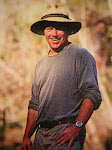Looking back on my life’s path over the last 50 years, I now see it was inevitable that I became a river guide. Put every job I worked and every passion pursued into a big pot, add river water, stir and then pour the mixture into a canoe-shaped vessel, and the glob will congeal into a funky hat with a river guide under it.
One of my earliest passions was outdoor survival—especially edible wild plants. In those days of the early 1970’s, information about edible plants was scarce. Euell Gibbons and a few others had written books, but they invariably discussed plants from other parts of the country. Fortunately, we had our own edible plants guru right here in Gainesville, a botanist named Margaret Cole.
Margaret was the perfect forager. Not only did she know how to find and prepare every wild edible in North Florida, she also knew how to defend her favorite foraging grounds from her fiercest competitors, her students.
At first, I didn't understand her genius. With every lesson about a certain plant, Margaret included a description of the best locations in North Florida to pick it. I was pleased to learn that edible wild plants thrived in every habitat imaginable and often had ranges that spanned the entire State and beyond. Oddly, however, it seemed none of them grew close to our hometown of Gainesville. Margaret’s directions always started with, “drive about 2 hours …”
Even as a teenager I understood the basic principal of foraging—take in more energy from food than you use in getting it. Driving two hours for wild foods seemed like a losing proposition. I soon arrived at that uncomfortable place in my thinking known to all hunters and foragers alike; the place where rationalizations fail and we must admit (to ourselves , but rarely to others) that we can get it cheaper at the store. It is here that the hunter must rise above mere intelligence and admit that he enjoys killing animals, for whatever reason. Plant foragers have different motivations. For most of us, the driving force is the challenge of living off the land.
In the end, my inner cave-man pummeled my inner accountant and gave me the go-ahead to embrace my new passion. Many weekends of my teen years began with me hopping into my old ’63 Valiant and setting off for the obligatory 2 hour drive to….wherever.
It wasn't until I discovered lots of great edibles growing in Gainesville--even in the heart of town--that Margaret’s clever deception revealed to me. But, I didn't feel deceived. I had learned a lot from those foraging trips, including many new and amazing places and a deeper appreciation for plants. Nothing infuses a plant with the aura of value more than having to drive two hours to find it. To this day, when I come upon a patch of dandelions, my first instinct is to stuff my pockets with their treasured leaves. But this level of appreciation can be a hard sell. Patsy listens politely and nods patiently when I explain that as a “good provider” it is my duty to keep dandelions and other edible “weeds” flourishing in our yard; then she points to the mower.
Today, foraging is much more popular than the Euell Gibbons days. It’s even crept into “civil” society as growing numbers of gourmet chefs are recognizing the value of using wild edible plants, for both the unique flavors and for their chic-appeal to environment-minded millennials.
For me, the greatest value of the interest in wild edibles is that it makes people mindful of their natural environment. It also heightens awareness of the un-natural environment. Nobody who’s eaten dandelions or read about their amazing edible and medicinal properties can ever again watch a TV herbicide commercial in which the spokesman—perhaps a ruggedly handsome yard-guy with a thick Scottish accent—implores you to poison these green treasures in your yard, without feeling like he just kekked yerrr dog.
Best of all, foraging is easy. Bookstores now carry many books about edible wild plants. Some deal specifically with Florida species. It’s as easy as buying a foraging guide (as well as a good plant ID field guide—very important!) and heading to the woods. But before you go please note, no edible plants grow anywhere near Gainesville. To find them, you’ll need to crank up your car and drive two hours ….
*

1 comment:
I'd love to go on a foraging trip with you sometime!
Post a Comment